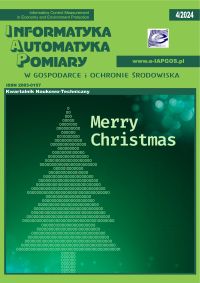WPŁYW ALGORYTMÓW STEROWANIA ROBOTEM MOBILNYM NA PROCES UNIKANIA PRZESZKÓD
Piotr Wójcicki
p.wojcicki@pollub.plPolitechnika Lubelska, Instytut Informatyki (Polska)
http://orcid.org/0000-0002-0522-6223
Paweł Powroźnik
Politechnika Lubelska, Instytut Informatyki (Polska)
http://orcid.org/0000-0002-5705-4785
Kamil Żyła
Politechnika Lubelska, Instytut Informatyki (Polska)
http://orcid.org/0000-0002-6291-003X
Stanisław Grzegórski
Politechnika Lubelska, Instytut Informatyki (Polska)
http://orcid.org/0000-0001-7640-6195
Abstrakt
W artykule przedstawiono algorytmy sterowania robotem mobilnym. Wykorzystano algorytm oparty o sztuczną sieć neuronową oraz logikę rozmytą. Odległość od przeszkód mierzono za pomocą czujnika ultradźwiękowego. Scharakteryzowano zastosowane urządzenia oraz algorytmy przetwarzania sygnałów. Testy przeprowadzono na mobilnym robocie kołowym. Przeprowadzono analizę wpływu algorytmów sterowania podczas omijania przeszkód.
Słowa kluczowe:
robot mobilny, algorytmy, unikanie kolizjiBibliografia
Adib A., Masoumi B.: Mobile robots navigation in unknown environments by using fuzzy logic and learning automata. Artificial Intelligence and Robotics (IRANOPEN), 2017, 58–63 [doi: 10.1109/RIOS.2017.7956444].
Google Scholar
Bajrami X., Dërmaku A., Demaku N., Maloku S., Kikaj A., Kokaj A.: Genetic and Fuzzy logic algorithms for robot path finding. 5th Mediterranean Conference on Embedded Computing (MECO), 2016, 195–199 [doi: 10.1109/MECO.2016.7525739].
Google Scholar
Boujelben M., Ayedi D., Rekik C., Derbel N.: Fuzzy logic controller for mobile robot navigation to avoid dynamic and static obstacles. 14th International Multi-Conference on Systems, Signals & Devices (SSD), 2017, 293–298 [doi: 10.1109/SSD.2017.8166963].
Google Scholar
Hammed A. A., Karlik B., Salman M. S.: Back-propagation algorithm with variable adaptive momentum. Knowledge-Based Systems 114, 2016, 79–87 [doi: 10.1016/j.knosys.2016.10.001].
Google Scholar
Handayani A. S., Dewi T., Husni N.L., Nurmaini S., Yani I.: Target tracking in mobile robot under uncertain environment using fuzzy logic controller. 4th International Conference on Electrical Engineering, Computer Science and Informatics (EECSI), 2017, 1–5 [doi: 10.1109/EECSI.2017.8239079].
Google Scholar
He K., Sun H., Cheng W.: Application of fuzzy neural network based on T-S model for mobile robot to avoid obstacles. 7th World Congress on Intelligent Control and Automation, 2008, 8282–8285 [doi: 10.1007/978-3-540-88513-9_120].
Google Scholar
Khan S., Ahmmed M. K.: Where am I? Autonomous navigation system of a mobile robot in an unknown environment. 5th International Conference on Informatics, Electronics and Vision (ICIEV), 2016, 56–61 [doi: 10.1109/ICIEV.2016.7760188].
Google Scholar
Mazare A., Ionescu L., Lita A., Serban G., Ionut M.: Mobile system with real time route learning using Hardware Artificial Neural Network. 7th International Conference on Electronics, Computers and Artificial Intelligence (ECAI), 2015, 45–48 [doi: 10.1109/ECAI.2015.7301250].
Google Scholar
McCulloch W., Pitts W.: A logical calculations of the ideas in nervous activity. Bulletin of Mathematical Biophisics 5, 1943, 115–133.
Google Scholar
Mohammad S. H. A., Jeffril M. A., Sariff N.: Mobile robot obstacle avoidance by using Fuzzy Logic technique. IEEE 3rd International Conference on System Engineering and Technology, 2013, 331–335 [doi: 10.1109/ICSEngT.2013.6650194].
Google Scholar
Panigrahi P.K., Ghosh S., Parhi D.R.: A novel intelligent mobile robot navigation technique for avoiding obstacles using RBF neural network. International Conference on Control, Instrumentation, Energy and Communication (CIEC), 2014, 1–6 [doi: 10.1109/CIEC.2014.6959038].
Google Scholar
Powroźnik P., Czerwiński D.: Effectiveness comparison on an artificial neural networks to identify Polish emotional speech. Przegląd Elektrotechniczny 07/2016, 45–48 [doi: 10.15199/48.2016.07.08].
Google Scholar
Stączek P.: Digital signal processing in ultrasonic based navigation system for mobile robots. ITM Web Conf. 15, 2017 [doi:10.1051/itmconf/20171505008].
Google Scholar
Tiwari S., Naresh R.: Comparative study of backpropagation algorithms in neural network based identification on power system, International Journal of Computer Science and Information Technology 5(4), 2013, 93–107 [doi: 10.5121/ijcsit.2013.5407].
Google Scholar
Wu T. F., Tsai P. S., Hu N. T., Chen J. Y.: Use of Ultrasonic Sensors to Enable Wheeled Mobile Robots to Avoid Obstacles. Tenth International Conference on Intelligent Information Hiding and Multimedia Signal Processing, 2014, 958–961 [doi: 10.1109/IIH-MSP.2014.240].
Google Scholar
Yong L., Yang F., Hui L., Si-Wen Z.: The Improved Training Algorithm of Back Propagation Neural Network with Selfadaptive Learning Rate, International Conference on Computational Intelligence and Natural Computing, 2009, 73–76 [doi:10.1109/CINC.2009.111].
Google Scholar
Autorzy
Piotr Wójcickip.wojcicki@pollub.pl
Politechnika Lubelska, Instytut Informatyki Polska
http://orcid.org/0000-0002-0522-6223
Autorzy
Paweł PowroźnikPolitechnika Lubelska, Instytut Informatyki Polska
http://orcid.org/0000-0002-5705-4785
Autorzy
Kamil ŻyłaPolitechnika Lubelska, Instytut Informatyki Polska
http://orcid.org/0000-0002-6291-003X
Autorzy
Stanisław GrzegórskiPolitechnika Lubelska, Instytut Informatyki Polska
http://orcid.org/0000-0001-7640-6195
Statystyki
Abstract views: 305PDF downloads: 145
Licencja

Utwór dostępny jest na licencji Creative Commons Uznanie autorstwa – Na tych samych warunkach 4.0 Miedzynarodowe.
Inne teksty tego samego autora
- Piotr Wójcicki, Tomasz Zientarski, ZASTOSOWANIE POTENCJAŁU LENNARD-JONESA DO MODELOWANIA RUCHU ROBOTÓW , Informatyka, Automatyka, Pomiary w Gospodarce i Ochronie Środowiska: Tom 9 Nr 4 (2019)
- Paweł Powroźnik, Dariusz Czerwiński, WPŁYW FUNKCJI OKNA NA SKUTECZNOŚĆ IDENTYFIKACJI STANU EMOCJONALNEGO MÓWCY , Informatyka, Automatyka, Pomiary w Gospodarce i Ochronie Środowiska: Tom 7 Nr 4 (2017)
- Kamil Żyła, WYDAJNOŚĆ IMPLEMENTACJI PODSTAWOWYCH METOD CAŁKOWANIA W ŚRODOWISKU APP INVENTOR , Informatyka, Automatyka, Pomiary w Gospodarce i Ochronie Środowiska: Tom 5 Nr 1 (2015)




